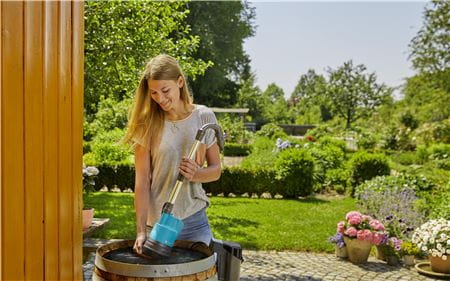
Drought Adaption Part 1 - Water Management
In our last blog we considered how we can reduce water usage in our gardens given recent weather conditions and imminent hosepipe ban. These tips and tricks were small changes that could be made quickly during the summer. However, as the climate continues to change, temperatures in this country will rise and heatwaves and drought conditions may become more common in the UK[1]. We might not need to worry about water so much for the rest of the year, but how can we better adapt and re-design our gardens to cope with dry periods in the future?
The thoughts we have assembled broadly fall into three different groups:
- Water management and saving.
- Shade and heat management.
- Plant selection & planting location.
We decided to break this up into a series of blogs. Today we’ll focus on water management; let’s have a look:
Water management and saving
In England and Wales most of the water we use in our daily lives comes from ground water, mainly collected in reservoirs (about two thirds), and underground sources (aquifers) accounting for another third[2]. Aquifers require suitable geology, and although below the surface, the amount of water available is determined by rainfall, albeit somewhat delayed in comparison to reservoirs. That supply is finite. Reservoirs collect water from streams and rivers where it is kept until it is needed. These reservoirs need lots of land on a suitable site and expensive civil engineering. As temperatures increase, our demand for water is likely to as well. Since Aquifers are finite, chances are we will need to build more reservoirs (or consider other expensive alternatives), if we want to use more water. Water has a large environmental footprint too. Those reservoirs destroy habitat and require huge amounts of concrete and other building materials. It takes lots of chemicals and energy to clean and pump that water too. So, perhaps before we flood the country in expensive reservoirs, we should use what we have first, as best we can. Our gardens represent an opportunity.
It’s worth pointing out that chlorine in tap water isn’t particularly good for plants or soil health[3], so if we want the best for our gardens; we shouldn't really use tap water. Of course, we could filter the water to take out the chlorine; but this will be expensive. What is far better is to use that nice pure wet stuff that falls on our gardens now and then (or quite a lot, traditionally, here in the UK), helping to keep your plants healthy and our mains water for other things.
So how can we adapt to use MORE rainwater in our gardens and LESS tap water?
-
Supercharge your water butt. In our last blog we pointed out that lots of people have a water butt, but often don’t use it, so can we come up with ways to make them more useful and remove some barriers to use? We think so and here’s a few thoughts:
- Increase the chances your water butt is full – A standard water diverter for a water butt, will not allow the water butt to overflow, so you don’t need to worry about it overfilling. Prioritise your largest roofs first and the smaller ones later (i.e. house before shed and greenhouse. If you only have one, put it on the house). The larger the roof feeding your water butt, the more likely it will be full when you need it, and the more water you will be able to collect in those brief summer rain showers. If you have a full water butt you will also get higher pressure.
- Increase the pressure – If you can get your water butt higher up than the normal stand, or purchase/build one that keeps more water higher up, you will increase the water pressure at the outlet, filling your watering can faster.
- Use a pump – Can’t get your water butt higher? Would like to use a hose or watering system? You can purchase water butt pumps that can be used to pump water out of your water butt that you may find useful.
- Use a watering system – Most watering butt outlets can be attached to a garden hose which can then take a timer or diverter valve. From there you can lay leaky pipes or similar (as long as they are below the outlet of the tank), if you have a pump, sprayers and misters are also an option. Irrigatia[4] produce interesting solar powered systems, but simple gravity-based systems can be created by normal watering products like the Gardena range we stock[5], and more complex systems with a mains powered pump.
- Supersize the tank – Most water butts are relatively small and don’t store a whole lot of water, but what if you could collect more? If you have some larger roofs to play with, perhaps consider a larger tank? Options include fixed to wall slimline tanks,[6] through commercial style water tanks like we use at the nursery,[7] and even underground rainwater storage tanks with pumping systems.[8] Tanks like these may allow you to have much more water on hand when you need it, collect more when it does rain, and store it for longer periods. If you’re investing in large tanks, we would recommend discussing this with an expert or doing some thorough research, as there are health concerns with storing water for long periods.

Gardena water butt pump. (above)
-
Think about run-off. Run-off is rainwater hitting hard surfaces like patio’s, driveways, and roofs; and running off into other areas, for example into drains. This is quite a big problem as much of our drainage systems have not been upgraded in a long time, and it leads to flooding and pollution events downstream. There are, however, ways to capture more of this in your garden without a bigger water butt, reducing some of this pressure, and hopefully helping to make your garden more resilient in dry periods.
- Less paving – The best way to limit run off is just to have less of it, but that only really helps with run-off not watering.
- Drain to the garden – I see a lot of paving these days draining towards the house with an Aco[9] drain or similar across the doors, draining directly to the mains. This not only channels storm water straight into the drainage system, but also takes all that water out of the garden, and if the drain were to block (happens here at the garden centre all the time) it may well flood your house. Try to fall paving away from the house and into the garden and plant this area up with plants that like to be well watered.
- Area’s too wet? – If you have wetter areas, for example next to a patio or driveway (like above), consider using a leaky pipe to move that water to a drier area of the garden.
- Permeable paving – Permeable paving is any paving that allows water through the surface, at its most basic gravel is a permeable paving solution, tarmac and paving stones usually aren’t. These days a multitude of products are available for permeable paving, including special paving stones & block pavers, reinforcement mats for grass and gravel & microporous resins and tarmac. By utilising solutions like this more moisture will be retained in your local environment, planting in and around these areas is likely to be more resilient than those around solid paving.
Pro Tip: When using these permeable surfaces, consider cut-outs for planting directly into the ground instead of pots on top, which dry out quickly. - After reading the last paragraph did you go out and buy a fancy underground rainwater collection tank? Re-divert that Aco drainage to it!
Video showing permeable Tarmac in action on YouTube. (above)
Although the surface of the soil may be dry there's often moisture lurking deep underground, that plants, particularly those with deep roots, can tap. The more water we allow to stay in our garden after rain events, the longer the soil retains moisture.
-
Reduce pots and planters. Smaller containers dry out quicker than larger ones, so think carefully before designing gardens that use lots of pots, small planters or hanging baskets. They are a lot more work in dry weather than those in the ground. If you're considering lots of pots consider large planters and raised beds, if you’re thinking about raised beds, could you make them bigger? Always try to leave the bottom of a raised bed open to the ground below to allow roots to grow deep and access water as far down as possible.
We hope some of these ideas gave you pause for thought on any future garden projects you might have, or helped you identify where you could make improvements. Next time we’ll discuss some ideas on how we can think about shade and temperature in your garden.
Bye for now…
[1] https://www.metoffice.gov.uk/research/climate/understanding-climate/uk-and-global-extreme-events-drought
[2] https://www.water.org.uk/advice-for-customers/water-and-health/
[3] https://gardenculturemagazine.com/chlorine-and-plants/
[5] https://www.layoftheland.co.uk/search?q=gardena+watering&type=product%2Carticle%2Cpage&options%5Bprefix%5D=last
[6] https://www.freeflush.co.uk/collections/rainwater-harvesting-systems/products/470-l-above-ground-pumped-rainwater-harvesting-system
[7] https://www.lbsbuyersguide.co.uk/steel-sectional-covers-to-fit-water-storage-tanks-various-sizes
[8] https://www.directwatertanks.co.uk/1800-litres-premium-underground-rainwater-harvesting-garden-system
[9] https://www.aco.co.uk/garage_threshold
